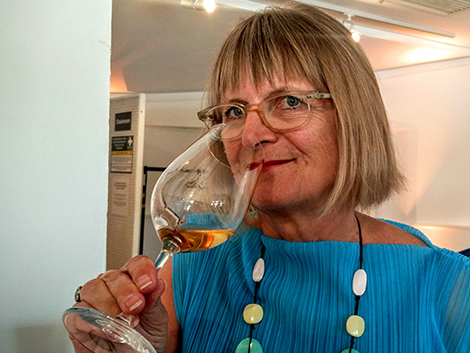
Brexit notwithstanding, the UK continues to be one of Spain’s largest export markets and certainly the country with which it has the longest trading relationship – from sherry and Rioja to more obscure wines. With the second edition of the ground-breaking Viñateros Trade tasting in London next week, we thought it a good moment to interview some of the UK’s most acclaimed wine experts to find out whether they think there really is a revolution underway in Spanish vineyards, and who they see as leading the wave.
I caught up with the world’s most influential wine writer, Jancis Robinson MW -on a visit to Madrid last year to launch her exceptionally fine wine glass range- leading Spanish and South American wine specialist, Tim Atkin MW, and blogger and wine science expert, Jamie Goode. All were very positive about what Spain is currently offering the wine enthusiast.
What do they see as the Spanish Wine Revolution?
The Viñateros “strapline” is “A Spanish Wine Revolution” – the organizers talk about the winemakers sharing a belief that great wine is made in the vineyard, and that site expression is more important than winemaking technique. This was backed up by the journalists, with Jamie Goode linking the Spanish wine revolution very clearly to the “natural” wine movement, “I see the trend for authentic or “natural” wines in the broadest sense of the word. Picking early, less extraction, less new oak so the fruit can really shine through. The use of old vine parcels that used to go into bulk wine production. Luis Gutierrez’s recent book (The New Vignerons: A New Generation of Spanish Wine Growers) was basically a roll call of natural wine producers from all across Spain.”
Jancis Robinson MW also mentions single vineyard wines, old vine bottlings, sustainability and the recuperation of old varieties as all being part of this ‘new wave’. “I’ve long been a fan of Garnacha, not that I’m anti-Tempranillo, but it made me sad that so much Garnacha has been pulled up, so I’m delighted to see more and more old vine Garnachas from places like Gredos and Aragón.”
For Tim Atkin, ‘new wave’ is “a state of mind”. The Master of Wine lists the key changes that the industry has undergone: “a move away from “formula” winemaking, which we saw a lot of in the 1990s and early 2000s. More and more people are picking grapes earlier, using less or no new oak and favouring freshness and balance over power and extraction. Terroir is being allowed to speak.”
The rebels and reformers
As for the key proponents, “there are lots of them and in every region. And they aren’t necessarily the youngest winemakers,” Atkin says. “You can be a rebel in your fifties and sixties. But I’d have to mention the Club Matador declaration, which was Telmo Rodríguez’s doing. I’m also very impressed by some of the groups in Rioja, like Rioja n’ Roll and Los Martes Locos, both driven by younger winemakers.”
Goode speaks of “a new kind of energy” in Spain at the moment. He mentions particular producers such as Eulogio Pomares in Rías Baixas as being “a genius making incredible wines” (Jamie visited his vineyard in 2018 and gave fantastic scores of up to 96/100).
“Also, of course, Raul Pérez and Willy Pérez and Ramiro Ibáñez in Jerez. Envínate are also doing great things in regions such as Ribeira Sacra and Tenerife, as well as producers such as Suertes del Marqués.”
Robinson also mentions Suertes del Marqués and Envínate as having opened up a new world of Spanish wine around the world, along with Rafael Palacios. “I tasted the first vintage of As Sortes and completely fell in love with it. I think it is one of the fine dry whites in the world.” She also spoke of Fernando Mora MW as being one of the winemakers to watch. “He is making very interesting wine and making a lot of noise about it. Anyone who becomes an MW to make wine is worth a look!” Robinson was also careful not to forget some of the bigger names. “I admire what Torres has been doing in terms of sustainability and recuperating old varieties, and they’ve been doing it for such a long time. I’ve followed the Torres story since the 1980s when they were planting French varieties in Spain, and of course the current Miguel is keeping up with the zeitgeist.”
Leading regions
As for exciting regions, all three journalists highlighted the Canary Islands, Atkin and Robinson both mentioned Gredos, and Atkin and Goode, Ribeira Sacra. The other regions varied, with Atkin listing Bierzo and Goode, Valencia, “where interesting things are happening with Bobal.” Robinson also named Alicante on the Mediterranean coast as an area she’d like to visit.
As for the big regions, Atkin, who recently published his annual Rioja report, name checked both Rioja and Ribera del Duero as established regions that are undergoing exciting change. Meanwhile, Goode believes “Rioja is a big industrial machine and although there are a few bright lights, it is a big ship to turn around. There are some producers such as MacRoberts and Canals, a South African lad who is doing what needs to be done in terms of finding old parcels that were servicing bulk wine and creating interesting wines out of them. I visited Ribera del Duero recently and the story is similar; most of the wines are old fashioned, over-extracted, using a lot of oak. Penedés and Cava are a mess at the moment.”
Goode also mentions Jerez, a region that Jancis -who recently published an article bemoaning the demise of sherry- and I spoke about in great depth.
“I hope that, if anything, my article encourages the odd sherry producer to be a little more proactive. I am encouraged by news that Peter Sisseck has moved into the area, because I think that’s what the region needs, to realise that they don’t need to be in a hermetically sealed Andalusian, dreamy, “mañana-ish” cloud. They need to be vindicated, and I think Peter’s move there is very healthy, I think they need to concentrate more on single vineyard wines, make them more like fine wine, send different wines, don't leave it to Equipo Navazos and The Wine Society to fly the flag for really interesting new wave, high quality sherries.”
She also went on to mention Fernando de Castilla as having “done a good job” and the sherries of Callejuela, who will be at Viñateros.
New wave Spain in the UK
As for getting their hands on these wines in the UK, Indigo Wines, the main organizer of Viñateros, is the importer that cropped up the most, along with H2Vin and the more traditional FMV.
When asked if UK consumers are truly interested in modern Spanish wines, Goode responds: “I hate talking about consumers in general as there are many different segments. The consumers who shop in Tesco still want Rioja and you’re not going to get through to them, although with time, as with haute couture fashion, the trend of less oak and picking earlier could trickle down. But with the sort of people I talk to, and the sort of restaurants I go to, Spain is back and it’s cool.”
The price issue
Affordability keeps coming up as both a selling point and a challenge for Spanish wine.
“My readers are more and more interested in this type of terroir-driven wines. Spain offers quality, value for money and a unique set of flavours and grape varieties,” says Atkin.
For Robinson, Spain offers “variety and it’s a source of such great value, particularly these old vine bottlings and old Rioja. A really aged Rioja is just as subtle as any French wine.”
Goode also values the affordability of Spanish wines. “I think that Spain is offering interesting wines at a price that I and other “ordinary” consumers can afford. In the UK, these are wines that retail between the low teens and £20, so not cheap, but affordable.”
But paradoxically, when asked what Spain should do to improve its offer, sustainable pricing was a key issue for both Atkin and Goode. The latter believes that “modest success is the enemy of true success. In Spain, there are too many producers at the bottom end who are just breaking even but have got by so long that it’s hard to break free from that. A good example of commercial done well is Peninsula wines, which are sustainable and affordable.”
Atkin echoes this. “The prices are still too cheap for the long-term health of the wine industry. Although for consumers this is a great time to be drinking Spanish wine.”
The value of Viñateros
According to Robinson, Viñateros is exactly the sort of promotional activity that wineries should be getting involved with. “Producers need to travel more. Come to London and New York, titillate people. Yes, you can give people a great wine in a glass but it doesn’t stay in the consciousness as long as it comes attached to a personality. Spanish wine needs ambassadors.”
Atkin, who highlights “the energy of the Spanish wine scene at the moment”, will miss Viñateros because he will be in Argentina, but Goode plans to attend the tasting in London. “You can see the spectrum of wines that are being produced, it gives a sense of perspective and I’m looking forward to discovering new things.”
I, for one, am certainly looking forward to catching up with some old faces and meeting some new winemakers at Viñateros, which will be taking place on the 25th February in London.

Anna Harris-Noble
A wine marketing professional with more than 20 years' experience in the UK and Spain, she holds a WSET Diploma and works as a consultant, freelance writer and translator. She has been Regional Ambassador for Spain for the Old Vine Conference since 2022.
Virtual wine tastings in March 2020
NEWSLETTER
Join our community of Spanish wine lovers





